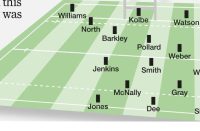Brendan Gallagher delves into some of rugby‘s most enduring images, their story and why they are still so impactful

Iconic Rugby Pictures: PART 88 William Barnes Wollen’s War of the Roses masterpiece
November 25, 1894
What’s happening here?
WE are pretty sure it’s November 25, 1894 at the old Fallowfield Stadium in Manchester and Yorkshire in the white are playing Lancashire in their traditional red hoops in the War of the Roses. Yorkshire’s Alf Barrowlcough, pursued by half of the Lancashire pack, is the player making the pass while the referee in the distance – in his distinctive suit and bowler, unquestionably looks like George Rowland Hill, the all powerful RFU secretary although the referee listed that day was a Mr T Potts from Durham. Perhaps a little poetic license there from the artist or perhaps a subtle political statement, more of which anon.
What is the story behind the painting?
The artist is William Barnes Wollen, born in Germany but educated in Britain, who studied and taught at the Slade for over 40 years and exhibited at the Royal Academy for just as long. Wollen was multi-talented and could turn his hand to many things. He had a quick eye and drew over 160 of the cartoon sketches to illustrate the early Sherlock Holmes stories by Sir Arthur Conan Doyle in the London Illustrated News and the Strand and later he accompanied the renowned author and journalist on his reporting trips to the western front during World War 1.
He was fascinated by rugby and an earlier picture – entitled ‘Football’ but actually a scene from a Halifax rugby game – is much admired while a delightful ‘Boys versus Men’ cartoon sketch in the Graphic demonstrates that Wotton totally got that rugby was a game for all shapes, sizes and character types.
Above all else though he carved a profitable niche as the pre-eminent painters of battle and military scenes. These could be contemporary – the Boer Wars and World War 1 – or historic scenes from the past. Wotten was besieged by Regiments wanting him to record either their existing campaigns or to commemorate previous feats of derring do and courage. No officers’ mess in Britain was complete unless it had a Wollen hanging over the fireplace. Meanwhile prints of his poignant painting ‘The Victoria Cross’ adorned many sitting rooms – the original resides at Durban Art Museum.
“The painting has pride of place in the President’s suite at Twickenham”
What happened next?
The painting was commissioned by the Newcastle firm of Mawson Swan and Morgan in 1894 and, after attending the game that year, Wotten also asked some players to sit individually before completing it the following year. It was exhibited at the 1896 Royal Academy summer exhibition (catalogue number 673) and displayed around the country for a couple of years before it disappeared for nearly 60 years.
It resurfaced again in 1957 when a member of the Yorkshire committee saw it in a second hand shop in Grey Street Newcastle. He promptly paid £25 for it and for a few years it was displayed at Otley RFC until it was moved to Twickenham where it has pride of place in the President’s suite in the West Stand.
Why is the picture iconic?
First there aren’t many rugby paintings that qualify as fine pieces of art per se but this is a rather superior piece. William Barnes Wollen, as we have seen, was a considerable if unusual artistic figure and here he has captured the essence of the day and the emerging sport. Many decades later Karl Mullen famously addressed his Grand Slam-seeking Ireland team and demanded “Bollock boot and bite” from his players and this picture captures that earthy rawness of rugby, you can smell the sweat and feel the wind and rain on your face.
It’s not fanciful or idealistic which is the whole point really. Wollen was a consummate painter of war scenes, he had just completed ‘The Black Watch’ at Bay Quatre Bras which is still considered among his best battle scenes. Rugby for him was a battle between opposing armies and you can almost smell the whiff of cordite in this picture.
The feeling of a sizable yet intimate crowd is tangible, the sense of occasion and public interest. It’s a big occasion and for a while Fallowfields was a big event venue. It was a “state of the art” athletics track and later a velodrome, while a year before this painting was started it hosted the 1893 FA Cup Final between Everton and Wolves. In 1897 England played Scotland in a Calcutta Cup fixture there.
And there is a poignancy. The completed canvas was unveiled in 1895 at about the same time that a number of northern clubs voted, at a meeting at the George Hotel in Huddersfield, to leave the Rugby Union and form the Northern Union. All this of course was over their wish to pay broken time payments to players who had missed work shifts to play for their clubs and indeed counties. Many of those involved in this picture would be playing Rugby League by the time it was displayed around the country in 1896.
Footnote. The referee is a distant ineffectual motionless figure in the background. Is Wollen making an unspoken comment on the RFU secretary Rowland Hill being unable to keep his beloved game under control? There is evidence of at least one figure in the painting being overpainted so is it possible that Hill is a very late addition to the piece. A satisfying little mystery!
























Pingback: find out here
Pingback: groeiserum